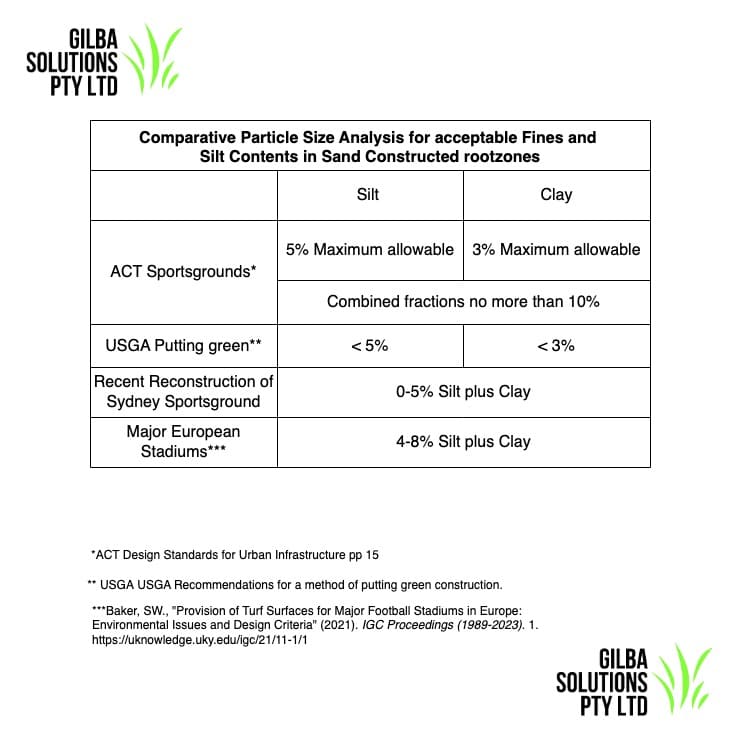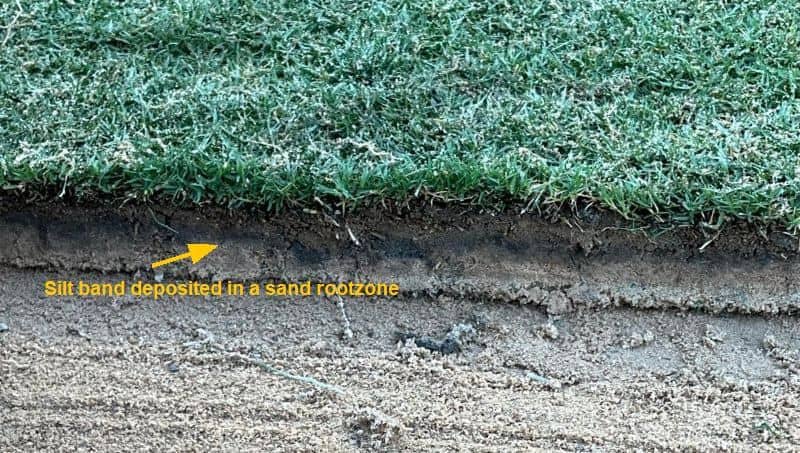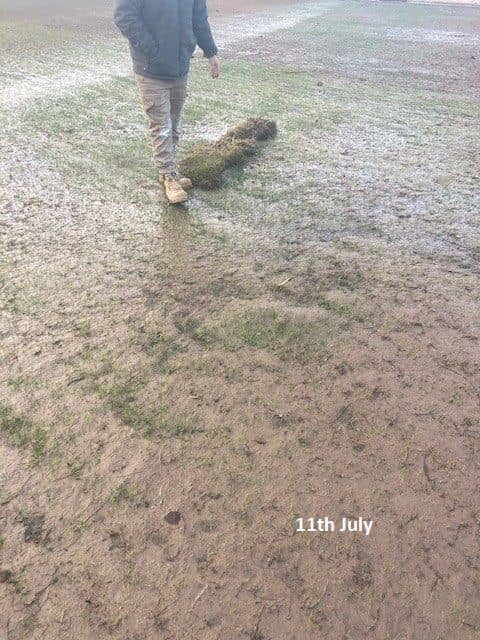The Impact of Fines on Sports Ground Drainage
We thought we would put an article together on what seems too be a current and future issue. The impact of fines on sport ground drainage on a sand profile sports field, and their impact on the infiltration rate of a soil.
The smallest of soil particles, can have a big impact on sports ground drainage, and how sports grounds perform. This is especially the case when you play on them in wet weather.
As a qualified Soil Scientist I have always taken an interest in the impact that these tiny particles have on the in filtration rate of a soil.
Internal tools:
- Argentine Stem Weevil Predictor.
- Overseeding Timing Guide.
- Soil Wetting Agent Selector.
- Traffic Tolerance Calculator.
- Turf Irrigation Calculator.
- Sand amendment calculator.
Sand Profile Sports Fields.
- Modern sports grounds often use sand to build their rootzone. The main reason for these sand profile sports fields is the benefit of improved soil drainage that allows play even after torrential rainfall.
- Sand based systems comprise a sand root zone, a gravel layer, and an underlying drainage system.
- The type of sand you use is very important as sands can vary a lot in their particle size and shape.
- The sand is placed over a gravel layer to create a perched water table above the gravel. This keeps the root zone moist in dry conditions.
- A drainage system is then installed under the gravel to remove any excess water.
- To maintain this freely draining medium it is important to maintain the drainage characteristics.
- Any fines contamination (silt and/or clay) will negatively affect the sports ground drainage, and the infiltration rate of the soil.
- If contamination occurs it tends to lead to issues with compaction and poor water infiltration into the profile.
- The rootzones of sand profile sports fields have a maximum allowable limit for ‘fines’. 1ACT Government’s Design Standards for Urban Infrastructure 2Recommendations for a Method of Putting Green Construction. 2004 3Baker SW. Provision of turf surfaces for major football stadiums in Europe :environmental issues and design criteria. 1995. Multifunctional Grasslands in a Changing World Volume 2, pp 283

What is The Impact of Fines on Sports Ground Drainage?
- ≥20% by volume of fines to a USGA sand, increases the soil moisture content to a point where it is unacceptable for trafficked turf sites4Brown, P.J., McCarty, LB., Quisenberry, VL., Hubbard, LR., & Addy, MB. (2019). Influence of Increasing Fines on Soil Physical Properties of U.S. Golf Association Sand. HortScience, 54(11), 2063-2066. https://www.doi.org/10.21273/HORTSCI14110-19.
- You should not add even a small amount of fine material without prior evaluation to a freely draining rootzone.
- In an 80:20 sand to silt + clay profile, a 2 cm layer formed under the turfgrass5Kesgin E, Gezici K, Tan Kesgin Rİ, Ağaçcıoğlu H, Karaagaçli M, Sağlam MT. Assessing Drainage Performance of Turfgrass Rootzone in Sports Fields. JARNAS. December 2024;10(4):803-818. doi:10.28979/jarnas.1530185. This slowed water infiltration of the soil. In this case, the impact of fines made this unsuitable for sports fields.
- A study in 1998 and 19996Henderson, JJ., Crum JR, Wolf TF, and Rogers, JN. 2005. Effects of Particle Size Distribution and Water Content at Compaction on Saturated Hydraulic Conductivity and Strength of High Sand Content Root Zone Materials. Soil Science. 170: 315–324. looked at the amount of silt and clay you can add to a sand in order to increase its strength without any loss in in the infiltration rate of a soil. Only those with 10% silt + clay or less had an acceptable, in terms of drainage (150-200 mm/hr).
Silt and Clay vs Sands.
- Silt particles are smaller than sand, but bigger than clay.
- Soils that contain a high proportion of fines are more easy to compact.
- When compaction occurs this reduces the soil pore space, and limits the movement of air and water through the soil.
- The air spaces and water channels in high silt content soils are more restricted than in sandy soils.
- Silt holds more moisture than a sand. This is due to a combination of surface area and pore size.
- Fine soil particles have a larger surface area than sand particles. As the surface area increases the amount of water that these fine particles can absorb increases.
What is Silt?
- Silt is a type of soil particle that has a floury feel when dry, and feels soapy or slippery when wet. Silt is often found in rivers, where it is transported by flowing water and deposited as sediment over the ground.
What is Clay?
- Clay is a fine grained material that has a particle size of 0.002 mm.
- Small clay particles are able to fit together more tightly than large grains of sand.
- Soils with high levels of clay tend to have more micropores.
- Clays can absorb a relatively large amount of water, and have a larger water holding capacity than sands.
- More of the water is unavailable in clay soils to plants than in sands.
- Clays retain soil water and do not drain as well as sands.
How Do Fines in Sand Profile Sports Fields Affect The Drainage?
Particle | Diameter mm* | Number of particles per gram | Surface area in cm2 |
Coarse Sand | 2-0.2 | 720 | 23 |
Medium Sand | 5,700 | 45 | |
Fine Sand | 0.2-0.02 | 46,000 | 91 |
Very Fine Sand | < 110 | 722,000 | 227 |
Silt | 0.02-0.002 | 5,776,000 | 454 |
Clay | < 0.002 | 90,260,853,000 | 8,000,000 |
* International Soil Science System ** Based on the Glycol retention method of Sor and Kemper (1959) Table based on Foth 1990. | |||
From a sports ground perspective, sand profile sports fields that have a high content of silt and clay tend to have lower soil infiltration rate in comparison to sand root zones.
A high content of fines negatively affect the infiltration rate of a soil7Sor, K., and W. D. Kemper. 1959. Estimation of hydrateable surface area of soils and clays from the amount of adsorption and retention of ethylene glycol. Soil Sci. Soc. Am. Proc. 23:105-110.. 8Foth HD, Fundamentals of Soil Science, 8th Edition, Michigan State University, John Wiley & Sons, New York, 1990.
These fine particles e.g. silt, reduce the pore space in sand profile sports grounds. This makes it harder for water to infiltrate and move through the soil.
The end result is surface pooling of water, reduced playability, and an increased risk of compaction and waterlogging, especially in wet weather.
Less Pore Space.
Silt particles have a much smaller particle size than sand particles. This means that there is much less space between the particles for any water to flow.
So high levels of silt in a sand rootzones will limit how quickly the profile, and in some cases the surface drains. This lowers the infiltration rate of a soil.
Lower Infiltration.
When there is a high level of silt or clay present in the soil, water takes a much longer time to move through the soil in comparison to a clean sand profile sports field. This is because the finer silt particles form a physical barrier to water flow.
Layering of Particle Sizes.
- Less wear tolerance.
- Greater soil compaction.
- Poor rooting of the turf.
- More disease.
- Poor water infiltration.
Surface Pooling of Water.
Because the drainage is impeded, water tends to build up at the turf surface. When it rains the result is wet, muddy conditions.
When soils with a high silt content become wet, the fine silt particles tend to float in the water. As a result, when these soils come under any degree of pressure it’s easy for these silt particles to be pushed into soil voids.
In areas that are compacted the result is shallow rooted grass where this compaction occurs.
Increased Compaction.
High levels of silt in sand rootzones are more prone to become compact. This in turn further reduces sports ground drainage capacity.
Soil Type | Hydraulic Conductivity (HC) and Bulk Density (BD) | Degree of Compaction | ||
4 Drops | 8 Drops | 16 Drops | ||
USGA Specification sand. <1.5% silt | HC mm/hr BD g/cm3 | 1950 1.48 | 1425 1.53 | 1195 1.58 |
Sand with too many fines; (38%) with 12% silt | HC mm/hr BD g/cm3 | 650 1.47 | 240 1.56 | 85 1.63 |
Sandy Loam. 20% Fines and 7% silt/clay | HC mm/hr BD g/cm3 | 1050 1.27 | 585 1.36 | 305 1.47 |
16 Drops is the equivalent to heavy winter games use | ||||
When you play on soils with a high silt content in wet weather, there can be large increases in the soil bulk density. In some cases this means that the infiltration rate can drop to < 2 mm per hour.
Playability.
Soils becomes less able to cope with wear when they drain poorly. This is due to the shallow root zone and water remaining at the surface.
How To Limit The Impact of Fines on Sports Ground Drainage?
To limit the impact of fines in sand rootzones, consider the following:
Ensure that you use Turf that is Free of Silt and Clay.
This may seem like common sense, but we have often seen unwashed turf put down over sand root zones. This is despite the fact the turf is clearly contaminated with finer material.
If the site is a new construction or if you are re-turfing you must make sure to limit the impact of fines on the sand rootzone. The easiest way to do this is to ensure the turf is clean of fines like silt and clay.
We were recently involved with the specification for a major Sydney venue. The project involved resurfacing the ground, and due to time and quality constraints, the turf had to be silt free and also not from an area prone to flooding.
There were two reasons for this:
- There was a very small window to carry out the required work. This meant if a turf farm flooded the window for the work would be compromised due to limited road access.
- For all the reasons above the turf needed to be silt and clay free. Washing would remove the majority of the fines, but there was always the concern that there was potential for root zone contamination to occur.
Flooding.
- If turf grass is buried under sediment for any period of time, it damages the grass due to a lack of light and smothers the vegetation.
- Any Silt and clay that is deposited over an existing freely draining root zone will tend to cause long term infiltration and sports ground drainage issues.
- This blog covers helpful tips on how to limit turfgrass damage in floods.
This makes it very important to remove this sediment from sand root zones as it stops a surface cap of silt and clay over the profile.
- The key to manage this is to let it dry out.
- Break up the layer with a drag mat.
- Carry out an intensive program of hollow tine aeration.
- Topdressing helps to dilute the sediment, and will go some way to preventing it from clogging the rootzone.
- If you top dress it’s important to use material that matches the particle size of the existing rootzone sand.
Optimized Sand-Silt/Clay Ratio.
Make sure that the root zone material that you use in a grounds construction has a high percentage of sand to facilitate water flow. See the specification above.
Subsurface Drainage.
The installation of an efficient drainage system helps remove excess water from the root zone. That’s obviously under the proviso that water can actually bypass any surface issues and reach the underlying drains.
Reduce The Impact of Fines on Sports Ground Drainage By Topdressing
Regularly topdress with sand. This helps with the drainage and aeration. This is even more important if the soil is compact or the surface is contaminated with silt or clay.
Aeration:
Aerating the turf can help break up compaction and improve water infiltration. However, if silt or clay contamination is the issue this won’t fix the problem in the long term.
In fact there is an argument that if the silt or clay is present at the surface if you punch holes to depth it may physically move this fine material further down into the root zone.
How to Determine if a Silt or Clay Problem Exists.
- Determining if you have a silt or clay problem can go a major way towards identifying if this is the cause of poor water infiltration.
- The maximum rate at which water enters a soil is called the infiltration capacity. Different soils have different infiltration capacities.
- A freely draining Sportsground with a sand rootzone can have an initial infiltration rate of over 1000 mm/Hr.
- In contrast, a soil with a high silt/clay content can have infiltration rates below 10 mm/Hr.
How to Test if Fines in Sports Ground Drainage are a Problem?
If you suspect you have an issue with fines contamination there are a few easy tests you can carry out before you send samples away to a laboratory for testing.
The following are in increasing difficulty.
Pot Test For Fines in Sports Ground Drainage.
The simplest test is to carry out a “pot test”. Thanks to McIntyre and Jacobsen for this.
- Take a small pot and fill it with the rootzone material.
- Then drop it for 4 x from about 100 mm.
- Add water to the top of the pot.
- If a significant amount of dirty water runs out of the pot then it probably has a high level of silt.
- In contrast, if the soil has low silt levels, the water will not be dirty when it comes out of the bottom of the pot.
Jar Test For Fines in Sports Ground Drainage.
This enables you to make a relatively quick approximation of how much silt and clay is present.
- Take a soil sample from the area.
- Put the soil sample in a transparent, clean, straight sided glass or plastic jar. Make sure it has a sealable lid.
- Fill the container with a 1% salt solution, and make sure that you leave space at the top of the jar.
- Close the lid and shake the jar and its contents for a few minutes. This will thoroughly mix the contents.
- Put the jar to one side and allow it to settle for 24 hours.
- After 24 hours you should be able to see layers of soil in the jar. These layers correspond to different soil particle sizes. Clay is at the top, silt in the middle and sand at the bottom.
- Take a ruler or tape measure and use it to measure the depth of each layer.
- If you divide the depth of each layer by the total depth and multiply it by 100 you can determine the rough percentage of each particle type.
Check the Infiltration Rate.
Infiltration Rings.
The final test to carry out before you send samples away is to use what is called a double ring infiltrometer. This is a relatively simple and accurate way to measure the infiltration rate “in-situ”, and the potential impact of fines on a sand rootzone.
Some factors that affect the infiltration capacity at the soil surface are:
- Soil compaction caused by machinery, concerts or play.
- Fine particles such as silt and clay washing into surface pores, and
- Cracks and fissures (macro pores).
The double ring method has a number of advantages over a single ring infiltrometer. The main one is that it measures the water infiltration without the loss of water by sideways movement. This often occurs if you use a single ring infiltrometer.
The metal ‘infiltration rings’ are partially pushed into the soil and you then fill them with water. You then measure the speed of water infiltration. The double ring limits the lateral spread of water after infiltration.
Double ring infiltrometers come in various sizes and the small units are really simple to use. However, they do have limitations.
Limitations of the Double Ring Infiltrometer.
- A double ring infiltrometer is very sensitive to fissures, cracks or aeration holes. Any of these will result in a much faster flow of water than you would otherwise see. As many of these cracks are often not visible at the surface it is not always possible to avoid them when you choose a site.
- The results from small rings do not always agree with those from larger units. It’s common for people to often use small infiltrometers as they are much easier to than the larger sets of rings. Small units are easy to carry and use less water.
- However, the affects of lateral and horizontal flow are much greater with small double ring infiltrometers. In fact small rings tend to overestimate the infiltration rate.
- If you use larger rings, the proportion of water lost to sideways movement is a lot less. This means that they are more accurate.
- In some situations it is not practical to measure the infiltration rate of a sand rootzone.
- On some sites where hybrids turf or replacement systems are present, the presence of a backing or a reinforcement material gives a false reading and overestimates the infiltration rate.
How to Use a Double Ring Infiltrometer.
Installation.
- With a water-resistant marker pen draw a line on the outside of the larger ring. This should be 50 mm up from the sharp edge. This marks the depth you are going to push the ring into the soil.
- Position the outer ring in place, and centre it in the desired location.
- Push the outer ring into the soil to a depth of 5 to 10 cm. Make sure to disturb the soil as little as possible.
- Install the inner ring inside the outer ring. Make sure you place this in the centre of the outer ring.
- Push the inner ring into the soil. It wants to be at the same depth as the outer ring.
Fill with Water.
- Fill the outer ring with water. Then fill the inner ring. The water level should be the same in both.
- Maintain a constant water level in the rings using a float or regularly refill them.
- Keep the water in the inner and outer ring at a similar level. If the water in the outer ring gets higher than the inner ring it will cause a decrease in the infiltration rate of the inner ring.
- A lower level in the inner ring causes less buffering against lateral spreading.
Measure the Infiltration Rate.
- Time the periods for each measurement.
- Record the amount of water that moves into the soil at each time interval.
- Calculate the infiltration rate (e.g., mm/hour). This is based on the amount of water that infiltrates and the time interval.
- Stop measuring only if the infiltration rate has reached a constant value.
Repeat as Required.
- Repeat the measurement process at regular intervals (e.g., every 15 minutes for the first hour, then every 30 minutes).
- Analyze the data to determine the average infiltration rate.
Conclusion.
Hopefully you have found this article of interest. We have discussed the impact of fines on sports ground drainage and how these small particles can cause big issues with the infiltration rates of soils.
These small soil particles can have a major impact on water movement in modern day sports ground constructions. Bearing this in mind, every effort should be made to reduce any potential for contamination of these freely draining soil profiles.
References

Jerry Spencer
Jerry has an Hons Degree in Soil Science (1988) from Newcastle Upon Tyne University. He then worked as a turf agronomist for the Sports Turf Research Institute (STRI) until 1993.
He gained a Grad Dip in Business Management from UTS in 1999. He has held a number of technical roles for companies such as Arthur Yates (Commercial Technical Manager) and Paton Fertilizers (Organic, turf specialty and controlled release fertiliser) portfolios.
In 2013 he established Gilba Solutions as independent sports turf consultants and turf agronomists. Jerry has written over 100 articles and two books on a wide range of topics such as Turf Pesticides and turfgrass Nutrition which have been published in Australia and overseas.


